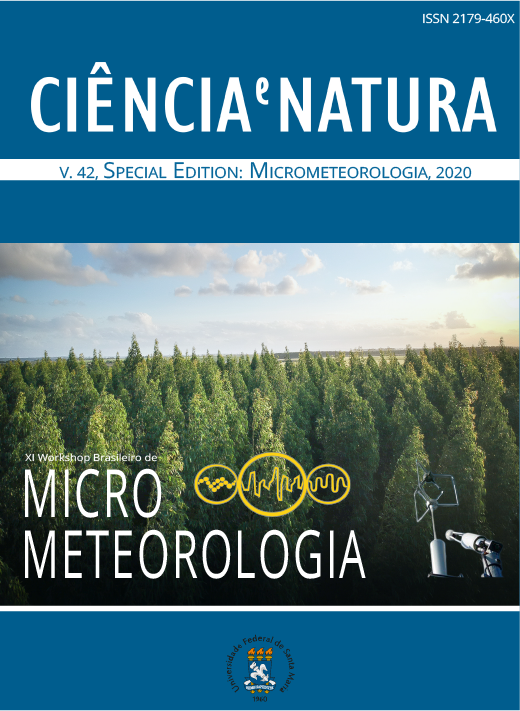Assimilação de dados para previsão na área terminal do Rio de Janeiro
DOI:
https://doi.org/10.5902/2179460X53224Palavras-chave:
Assimilação de dados, WRF, 3D-Var, Dados de superfície, Dados de perfilResumo
O processo de assimilação de dados, onde observações meteorológicas e previsões do tempo são combinadas para fornecer um campo de análise, tem sido muito estudado pela comunidade científica e por centros operacionais. A utilização do método variacional 3D (3D-Var) implementada no modelo Weather Research and Forecast (WRF) é avaliada para assimilação de dados na Área Terminal do Rio de Janeiro (TCA-RJ). O objetivo principal de qualquer método variacional de assimilação de dados é produzir uma estimativa ótima do estado atmosférico no momento da análise. O campo de análise é estimado por um campo de estimativa inicial (campo de previsão anterior) e um campo de observações, ponderados pelas matrizes de erro. O WRF é configurado para nowcasting (previsão de até 6h) para a TCA-RJ através de ciclos de assimilação utilizando dados de superfície, sondagem e perfilhadores de vento. Os resultados preliminares mostram a sensibilidade de cada tipo de observação e encorajam a utilização desta técnica operacionalmente para fornecer suporte ao controle de tráfego aéreo controlado pela Força Aérea Brasileira.
Assimilação de dados; WRF; 3D-Var; Dados de superfície; Dados de perfilDownloads
Referências
BARKER, D. M., W. HUANG, Y.-R. GUO, A. BOURGEOIS, AND X. N. XIAO. A Three-Dimensional Variational Data Assimilation System for MM5: Implementation and Initial Results. Mon. Wea. Rev., 132, 897–914, 2004.
BARKER, D. M., X.-Y. HUANG, Z. LIU, T. AULIGNE, X. ZHANG, S. RUGG, A. A. AL KATHERI, A. BOURGEIOS, J. BRAY, Y. CHEN, M. DEMIRTAS, Y. GUO, T. HENDERSON, W. HUANG, H.-C. LIN, J. MICHALAKES, S. RIZVI, X.-Y. ZHANG. The Weather Research and Forecasting (WRF) Model’s Community Variational/Ensemble Data Assimilation System: WRFDA. Bull. Amer. Meteor. Soc., 93, 831–843, 2012.
CINTRA, R.S., CAMPOS VELHO, H. F. Global Data Assimilation Using Artificial Neural Networks In Speedy Model. Proceedings of the 1st International Symposium on Uncertainty Quantification and Stochastic Modeling, 2012.
DALEY, R. Atmospheric data analysis. Cambridge University Press, 1991.
DUDHIA, J. Numerical study of convection observed during the Winter Monsoon Experiment using a mesoscale two–dimensional model. J. Atmos. Sci., 46, 3077–3107, 1989.
GRELL, G. A. AND FREITAS, S. R. A scale and aerosol aware stochastic convective parameterization for weather and air quality modeling. Atmos. Chem. Phys., 14, 5233-5250, 2014.
HONG, SONG–YOU, JIMY DUDHIA, AND SHU–HUA CHEN. A revised approach to ice microphysical processes for the bulk parameterization of clouds and precipitation. 2004. Mon. Wea. Rev., 132, 103–120, 2004.
HONG, SONG–YOU, YIGN NOH, JIMY DUDHIA. A new vertical diffusion package with an explicit treatment of entrainment processes. Mon. Wea. Rev., 134, 2318–2341, 2006.
KALNAY, E. Atmospheric Modeling, Data Assimilation and Predictability. Cambridge University Press, 2012.
MLAWER, ELI. J., STEVEN. J. TAUBMAN, PATRICK. D. BROWN, M. J. IACONO, AND S. A. CLOUGH. Radiative transfer for inhomogeneous atmospheres: RRTM, a validated correlated–k model for the longwave. J. Geophys. Res., 102, 16663–16682, 1997.
SKAMAROCK, W. C., J. B. KLEMP, J. DUDHIA, D. O. GILL, Z. LIU, J. BERNER, W. WANG, J. G. POWERS, M. G. DUDA, D. M. BARKER, AND X.-Y. HUANG. A Description of the Advanced Research WRF Version 4. NCAR Tech. Note NCAR/TN-556+STR, 145 pp, 2019.
TEWARI, M., F. CHEN, W. WANG, J. DUDHIA, M. A. LEMONE, K. MITCHELL, M. EK, G. GAYNO, J. WEGIEL, AND R. H. CUENCA. Implementation and verification of the unified NOAH land surface model in the WRF model. 20th conference on weather analysis and forecasting/16th conference on numerical weather prediction, pp. 11–15, 2004.
Downloads
Publicado
Como Citar
Edição
Seção
Licença
Para acessar a DECLARAÇÃO DE ORIGINALIDADE E EXCLUSIVIDADE E CESSÃO DE DIREITOS AUTORAIS clique aqui.
Diretrizes Éticas para Publicação de Revistas
A revista Ciência e Natura está empenhada em garantir a ética na publicação e na qualidade dos artigos.
A conformidade com padrões de comportamento ético é, portanto, esperada de todas as partes envolvidas: Autores, Editores e Revisores.
Em particular,
Autores: Os Autores devem apresentar uma discussão objetiva sobre a importância do trabalho de pesquisa, bem como detalhes e referências suficientes para permitir que outros reproduzam as experiências. Declarações fraudulentas ou intencionalmente incorretas constituem comportamento antiético e são inaceitáveis. Artigos de Revisão também devem ser objetivos, abrangentes e relatos precisos do estado da arte. Os Autores devem assegurar que seu trabalho é uma obra totalmente original, e se o trabalho e / ou palavras de outros têm sido utilizadas, isso tem sido devidamente reconhecido. O plágio em todas as suas formas constitui um comportamento publicitário não ético e é inaceitável. Submeter o mesmo manuscrito a mais de um jornal simultaneamente constitui um comportamento publicitário não ético e é inaceitável. Os Autores não devem submeter artigos que descrevam essencialmente a mesma pesquisa a mais de uma revista. O Autor correspondente deve garantir que haja um consenso total de todos os Co-autores na aprovação da versão final do artigo e sua submissão para publicação.
Editores: Os Editores devem avaliar manuscritos exclusivamente com base no seu mérito acadêmico. Um Editor não deve usar informações não publicadas na própria pesquisa do Editor sem o consentimento expresso por escrito do Autor. Os Editores devem tomar medidas de resposta razoável quando tiverem sido apresentadas queixas éticas relativas a um manuscrito submetido ou publicado.
Revisores: Todos os manuscritos recebidos para revisão devem ser tratados como documentos confidenciais. As informações ou ideias privilegiadas obtidas através da análise por pares devem ser mantidas confidenciais e não utilizadas para vantagens pessoais. As revisões devem ser conduzidas objetivamente e as observações devem ser formuladas claramente com argumentos de apoio, de modo que os Autores possam usá-los para melhorar o artigo. Qualquer Revisor selecionado que se sinta desqualificado para rever a pesquisa relatada em um manuscrito ou sabe que sua rápida revisão será impossível deve notificar o Editor e desculpar-se do processo de revisão. Os Revisores não devem considerar manuscritos nos quais tenham conflitos de interesse resultantes de relacionamentos ou conexões competitivas, colaborativas ou outras conexões com qualquer dos autores, empresas ou instituições conectadas aos documentos.






